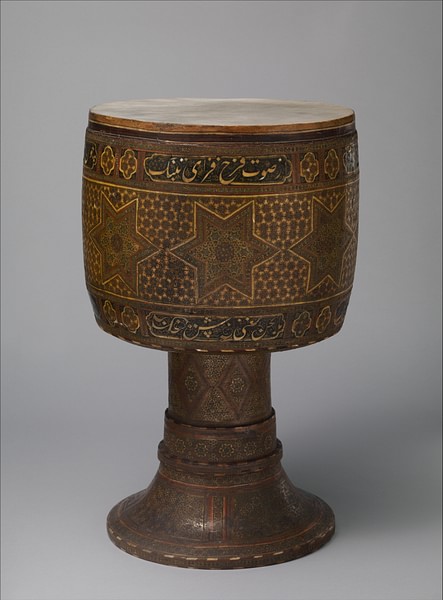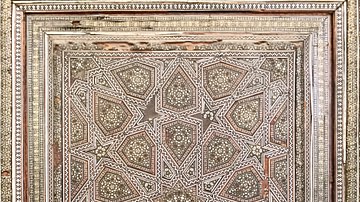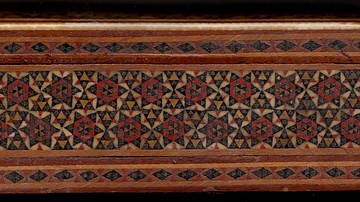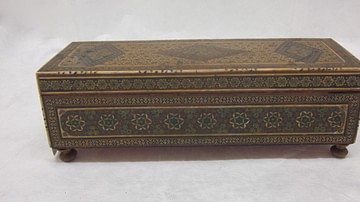
Khatam is a decoration technique used exclusively on wooden objects and one of Iran's finest and most delicate crafts consisting of geometrical patterns. Small squares or triangles are laid next to one another in different compositions, colors, and materials, creating larger units of design or motifs, which are repeated several times to make up a pattern.
Origin & History
The history of khatam has not yet been studied in depth and with as much attention as has been dedicated to other techniques. Although widely used and mastered in Iran, there is much debate concerning the origins of this art as early examples of the technique have been found in different regions such as China, India, Syria, etc., suggesting each as the origin of khatam. That being said, there are differences between the manners in which this art is practiced in each region. For example, in China, the colors used to create khatam are strictly limited to black and white which creates a certain dichotomy, while in Iran khatam is created also using other colors such as red and green.
Khatam is often times confused with or mistakenly categorized under the inlaying or marquetry techniques in various sources, but the technique has distinctive differences from the latter two in both the materials used and its design. While khatam is exclusively used to decorate the surface of wooden objects, inlay and marquetry can be used on a variety of materials. Furthermore, khatam solely uses geometrical designs and patterns, while the other two techniques consist of various shapes and designs with no limit.
Etymology & Technique
The word 'khatam' refers to the art itself, while the 'khatam sazi' and 'khatam kar' respectively refer to the workshop where it is created and the artisan practicing the art. There are a number of theories regarding khatam as a word and why it was used to refer to this particular technique. According to Anvari:
In Persian, the word Khatam literally means "reaching the end", it refers to somebody who has reached the pinnacle of achievement (Anvari, 2613)
Khatam uses geometrical patterns mostly designed by juxtaposing small triangles next to one another in various formations. In no other art techniques, using geometrical patterns, can such minute detailed designs and delicacy be found and that is why khatam is considered the apex and quite literally the "khatam" of all arts featuring geometrical designs. In some fine examples of khatam, the artisan has worked close to 200 rather miniature pieces into one cubic centimeter.
Khatam is used to decorate the surface of wooden objects which include doors, boxes, furniture, frames, and musical instruments among other objects. One of the main materials used to create khatam itself is different types of wood such as ebony, boxwood, pine, jujube, etc. These are included in the design either in their original state or colored by chemical dyes. Also used to create khatam are different types of bones which depending on the quality and the price of the final product vary from horse and camel bones to ivory and nacre. Metal wires are also included in the designs which, once again depending on the price and quality, range from brass to gold and silver wires.
The process of designing, creating, and working the khatam on the surface of the wooden object, from start to finish, requires a lot of attention and hard labor. The smallest unit of the designs can be both square or triangle, although the latter is more frequently used in Iran. From assembling small triangles next to one another in different compositions, colors, and materials, larger units of design or motifs are created. The repetition of these motifs forms the main design and pattern. Based on the final design and the decided material, wooden prisms and metal wires are glued together and wrapped by yarn to form narrow columns. A number of these columns are then once again glued together and pressed to get rid of any bubbles or spaces in between and form what is called qamen khatam. Using hand saws or machines, qamen is sliced into thin stripes of khatam, which are glued to the surface of the object and covered by lacquer or varnish to prevent any deterioration by moisture or dust.
The materials used to create the work determine the price of the final product, but there are certain characteristics that every good quality khatam must have. First and foremost, the wooden surface upon which the khatam stripes are glued must be completely smooth and without any bumps, which might occur for various reasons such as using too much glue or not pressing the stripes down properly. Furthermore, if the raw materials are dyed, the color of all prisms must be consistent and not change over time. Finally, the surface of the khatam itself must be fully covered by lacquer, while other surfaces that are not covered must be sanded and varnished.
The quality and value of the final product also depend on the design and its final execution. Each corresponding side of the pattern should preferably be symmetrical for better visual aesthetics. Moreover, the smaller the base units of the design, the harder the execution of the pattern and the more precious and valuable the khatam. Some artisans go as far as including more than 200 small triangles in only one cubic centimeter.
Some Examples
From the time when the earliest examples were found, the art of khatam has gone through periods of decline and growth throughout Iran's history. To this day, the art is still being practiced in full effect in Isfahan, Shiraz, and Tehran, and it is growing further in both the diversity of its designs and the decorated objects. Thus, there are numerous examples of khatam as a decorative art both in architectural settings and crafts that one can name, and the following are just a few instances where khatam was used to further elevate the already magnificent work of art.
The Marble Palace (Kakh-e Marmar) contains one of the most breathtaking examples of the art of khatam executed to perfection. The palace itself was built in the early 20th century during the Pahlavi Dynasty in Tehran, Iran, to the order of Reza Shah (r. 1925-1941). Although now the building is open to the public as a museum, the palace used to serve as a royal residence where important events took place. With its unique architecture, the halls and rooms within this historical building are adorned with a variety of techniques such as mirror works, tile works, carvings, paintings, etc. One of the most unique rooms of the palace is wholly decorated with Khatam. From the walls to the ceiling along with all the furniture and objects that are found in the room, everything is covered with some of the most precious and delicate works of khatam, making it one of the most valuable examples of this art today.
Gholamreza Roozitalab comments on the art of khatam during the Pahlavi era and in the Marble Palace in particular as following:
At the beginning of the Pahlavi period, with the establishment of art schools in Tehran, Isfahan, and Shiraz, under the reign of Reza Shah Pahlavi Khatam was revived… The Khatam chamber in the Marmar palace could be considered as the symbol of a new season of Khatam history. (Roozitalab, 64-68)
Also containing khatam decorations is the Golestan Palace, a former official royal Qajar complex in Tehran, Iran. It was built in the 16th century and has undergone several renovations ever since, one taking place in the 18th century. The complex contains a number of structures, all of which boast different decoration techniques which make each hall or room completely unique. From mirror works and stained glass windows to some of the most amazing examples of seven-colored tiles, the complex both on the interior and exterior is an absolute work of art. Unlike in the Marble Palace where a whole room is dedicated to the art of Khatam, in the Golestan Palace this technique is used on a smaller scale on surfaces such as doors and window frames. A great example of it can be seen on two pairs of wooden doors in the Royal Balcony of the Marble Throne. The khatam which covers the door panels is worked with materials such as silver, ivory, and camel bone, turning the doors into precious works of art.

And last but not least is the Jameh Mosque of Atigh, which is the oldest mosque of Shiraz, built during the 19th century. The main porch of the mosque along with its nearly 1000-year-old pulpit is covered with precious works of khatam, making them one of the well-known examples of this art.








